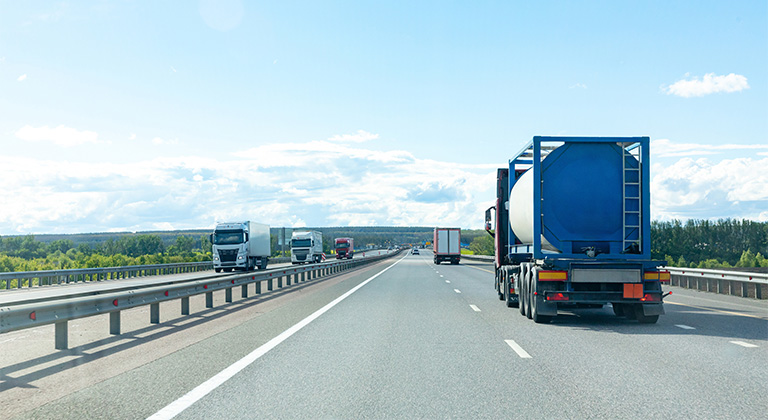Truck rear-end accidents
Rear-end accidents occur when one vehicle hits another from behind. These accidents can be limited to two vehicles, or they can become a chain reaction with multiple vehicles involved. Let’s explore the common ways these accidents happen and how to help prevent them.
Common causes and scenarios of truck rear-end accidents
Below you’ll find hypothetical scenarios that depict how rear-end accidents can happen. Whether you’re a truck driver or a standard vehicle driver, it’s important to know how certain behaviors may lead to rear-end accidents.
Distracted driving
Anything that takes your mental or physical attention from the road—even for a split second—can potentially cause an accident.
Scenario: The driver behind you looks down at their phone to read a text message. Because they aren’t paying attention, they don’t notice that you’ve come to a stop to let a pedestrian cross at a crosswalk, and they rear-end your vehicle.
Following too closely
Tailgating is often the cause of rear-end accidents as it leaves little room for a driver to adjust to the braking actions of the vehicle in front of them.
Scenario: A vehicle is following you too closely on the highway. You have to quickly apply your brakes when a vehicle in front of you cuts into your lane. The driver behind you hits your vehicle because the short distance between vehicles didn’t allow that driver enough time to appropriately react.
Blind spots and stopping distances
With a stopping distance close to the length of two football fields, trucks take almost twice as long to stop compared to a standard passenger vehicle. And oftentimes, other motorists enter a trucker’s front blind spot without understanding that the truck takes longer to slow down.
Scenario: You need to take an upcoming left turn, so you switch lanes and enter a truck’s front blind spot. As your turn approaches, you apply your brakes to wait for the opposite lanes of traffic to clear. The truck driver doesn’t see you and ends up rear-ending your vehicle.
Speeding
Speeding limits your reaction time and increases braking distance. If you or another driver slows to an unexpected stop, excessive speed can make it difficult to avoid a collision.
Scenario: You’re driving in a construction zone where the speed limit is reduced and traffic is limited to one lane. The vehicle behind you isn’t abiding by the speed limit and ends up rear-ending your vehicle when traffic in the single lane slows to a stop.
Adverse weather conditions
It’s always best to increase your following distance and slow down when weather conditions cause low visibility or slick roadways.
Scenario: It’s snowing—roads are quickly becoming slippery, and visibility is low. You’re approaching a stoplight. The light turns yellow, and the car in front of you has already begun to slow down. You apply your brakes too quickly and slide forward, rear-ending the vehicle in front of you.
How to help prevent truck rear-end accidents
Stay alert at all times
Avoid distractions, such as mobile devices, reaching for things out of your immediate grasp, and eating or drinking
Increase following distance (Link to new following distance article when ready)
Adjust your speed to the road conditions—and pay attention to changing speed limits
Slow down gradually, and avoid sudden stops
Use turn signals early to give other drivers warning of your intentions
Don’t abruptly change lanes in front of other vehicles
Consequences of a truck rear-end accident
Each rear-end accident is different. Vehicle damage, injuries, and financial implications can vary depending on the level of impact. Learn more about the basics of trucking accidents.
What to do if a truck rear-ended you
If a truck rear-ended you—or vice versa—there are several basic steps you need to take at the scene in the immediate aftermath:
Make sure your vehicle is in a safe location, if possible, and that your hazards are on
Check on the other parties involved if it’s safe to do so
Help the injured to the best of your abilities
Call 911 to report the crash and any injuries
Exchange insurance information with others involved in the crash
Take pictures of the crash from multiple angles, and get contact information from other parties and witnesses
If you can, get the police report number and contact information for tow companies and others responsible for clean-up
When following these steps, make sure you and the other people involved in the crash are safe from the traffic around you to help avoid any further incidents or injuries.
The documentation you gather about the accident—like photos, witness statements, or a police report—will be vital for the claims process to be resolved quickly and fairly. With this information in hand, reach out to your insurance provider to let them know about the accident.
Related resources
Trucking safety policies and accident procedures
Truck drivers and their employers can take certain steps to help ensure safety on the road. Know how to help reduce accidents—and how to respond if one does happen.
How to file a trucking accident claim
Learn how truck accident claims work—including how they differ from car accidents, and how you can help ensure a smooth process.
Reducing truck backing up accidents
Backing accidents occur when a vehicle strikes another vehicle, object, or person while the driver is backing up. These accidents are common and they can cause significant damage or injuries.




